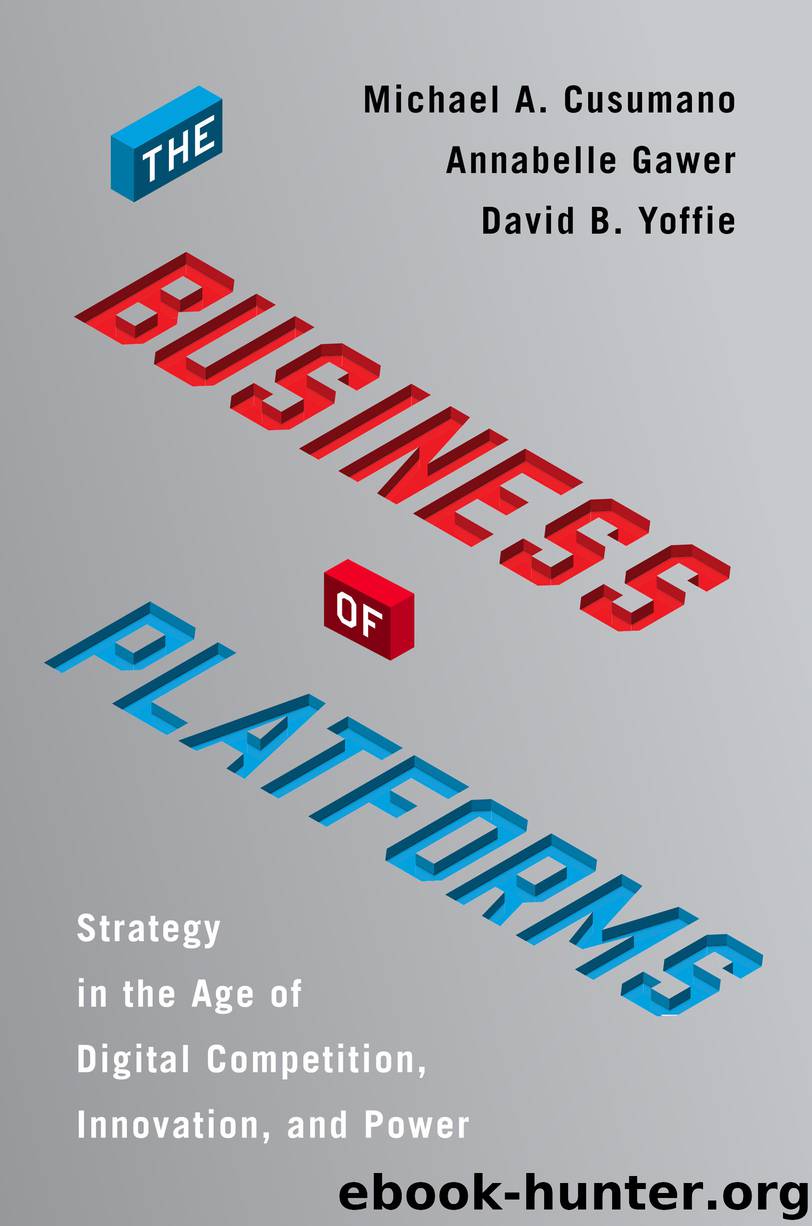The Business of Platforms by Michael A. Cusumano

Author:Michael A. Cusumano
Language: eng
Format: epub
Publisher: HarperCollins
Published: 2019-03-28T16:00:00+00:00
Buy a Platform (Especially the Technology and the Talent)
No one ever said that creating a platform business was easy. For many managers, particularly if they have strong balance sheets, the easy answer has been to buy a platform. But before heading down this path, it is important to recognize that buying your way into the platform world is fraught with danger. The skills to manage a platform can be antithetical to managing an old command-and-control organization. Notable disasters have included News Corporation’s acquisition of MySpace and the AOL-Time-Warner merger.
Yet under the right conditions, buying a platform may be the right answer. In businesses where new, emerging platforms are likely to capture a significant share (e.g., taxis and retail), incumbent firms cannot sit on the sidelines indefinitely. In general, the biggest risk in acquiring a platform has been not retaining key talent, integrating technology into legacy systems, and cultural rejection from the parent. But, as we’ll see in the Walmart example, there may be hope. Buying strong technology and empowering new, outside talent can sometimes overcome the natural obstacles to transforming an old dog into a new platform.
WALMART’S ACQUISITIONS
Few large incumbent companies have been more challenged by platform competition than Walmart, the biggest company in the world measured by sales and employees. “How did a peddler of cheap shirts and fishing rods become the mightiest corporation in America?” a Fortune columnist once asked. “The short version of Walmart’s rise to glory goes something like this: In 1979 it racked up a billion dollars in sales. By 1993 it did that much business in a week; by 2001 it could do it in a day.”35 That same year, Walmart also topped Fortune’s Global 500 list, and it retained the top spot for most of the next fifteen years. In 2017, its revenues were close to $500 billion, which outpaced the next largest company—China’s State Grid—by more than $150 billion in revenue.36 Walmart had become the dominant retailer on the planet by cutting costs ruthlessly in service to its everyday low-price model and steadily pushing competitors small and large out of business.
Walmart’s biggest threat came from e-commerce. Though a small fraction of overall retail sales (about 14 percent in 2017), online retail was growing much faster (about 16 percent in 2017), compared to the 1.4 percent overall growth in retail. Online U.S. sales were predicted to grow from $390 billion in 2016 to $612 billion in 2020.37 But, in the United States, Walmart faced head-on the new juggernaut of the retail world: Amazon. Although Amazon’s revenue was much less than half of Walmart’s in 2017, it was growing much faster: Amazon’s retail sales had grown at an annualized rate of nearly 20 percent between 2011 and 2015, while Walmart’s growth was in the low single digits. Amazon’s dominance in e-commerce was nearly as complete as Walmart’s dominance in brick-and-mortar retail. Amazon was also the world’s most valuable retailer in 2018, more than three times the market cap of Walmart. As the CEO of Adidas put it, “Amazon is the best, without any comparison, transaction platform in the world.
Download
This site does not store any files on its server. We only index and link to content provided by other sites. Please contact the content providers to delete copyright contents if any and email us, we'll remove relevant links or contents immediately.
Bad Blood by John Carreyrou(6583)
Rich Dad Poor Dad by Robert T. Kiyosaki(6513)
Principles: Life and Work by Ray Dalio(6296)
Playing to Win_ How Strategy Really Works by A.G. Lafley & Roger L. Martin(6083)
Management Strategies for the Cloud Revolution: How Cloud Computing Is Transforming Business and Why You Can't Afford to Be Left Behind by Charles Babcock(4546)
The Confidence Code by Katty Kay(4220)
Thinking in Bets by Annie Duke(4185)
American Kingpin by Nick Bilton(3819)
Delivering Happiness by Tony Hsieh(3396)
Project Animal Farm: An Accidental Journey into the Secret World of Farming and the Truth About Our Food by Sonia Faruqi(3189)
The Power of Habit by Charles Duhigg(3094)
The Tyranny of Metrics by Jerry Z. Muller(3028)
Brotopia by Emily Chang(3026)
Mastering Bitcoin: Programming the Open Blockchain by Andreas M. Antonopoulos(3011)
The Marketing Plan Handbook: Develop Big-Picture Marketing Plans for Pennies on the Dollar by Robert W. Bly(3006)
I Live in the Future & Here's How It Works by Nick Bilton(2960)
The Content Trap by Bharat Anand(2887)
Applied Empathy by Michael Ventura(2864)
Building a StoryBrand by Donald Miller(2863)
